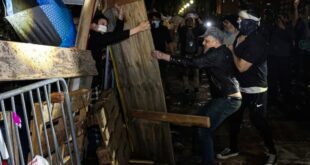CBC's Marketplace got tips from across the country on what you should do in an emergency

From record flooding in Nova Scotia to wildfires across Canada that forced thousands of people to evacuate their homes, it's been an unprecedented year for environmental disruption.
Statistics Canada says natural disasters and extreme weather events "are increasing in severity and frequency and are affecting Canadians and businesses on many fronts."
But Statscan also reports only a quarter of Canadians say they've taken steps to prepare for a weather-related emergency. So CBC's Marketplace travelled across the country to put together a survival guide to deal with natural disasters.
- Got a tip you think we should investigate? Reach us at marketplace@cbc.ca
Jeff Donaldson, principal researcher at Preparedness Labs Inc., an Ottawa-based consultancy, says Canadians don't need an individual plan for each disaster.
Instead, he says, we should prepare for the most likely scenario — a power outage — while also making plans for a potential evacuation.
"If you plan for the extremities of the continuum, you're more than likely to be ready for anything that may happen in the middle," said Donaldson.
Tornadoes and earthquakes
Preliminary data suggests that tornadoes will become more frequent in heavily populated areas in Ontario and Quebec, says Dave Sills, a former tornado investigator for Environment Canada.
Now the executive director of the Northern Tornadoes Project at Western University in London, Ont., Sills says the most dangerous aspects of a tornado are structures collapsing and debris flying, which is why he says the best advice is to protect your head and body from being hit.

Inside a tornado simulator
Featured VideoAt the WindEEE Research Institute in London, Ont., Marketplace host Travis Dhanraj experiences a simulation measuring how tornadoes could impact our homes.
The ideal way to protect yourself is to get to a safe place in your home, like the basement or inside a room on the lowest floor without windows, to shield yourself from broken glass.
Sills warns that you should close all windows and doors in a tornado, and as hard as it may be to resist, not to stand at your window to take a video of the storm.
"Lawn chairs and lawn furniture … these are projectiles in a big storm," he said, emphasizing that even in weak tornadoes, planks of wood can pierce walls.
If you're in a car, Sills advises you pull over, ensure your seatbelts are buckled and duck as low as you can, covering your head. If you're outside, he says to go to a ditch if you can, squat down and cover your head. Sills notes there's likely to be lightning in a tornado, so use this position to limit contact with the ground and reduce the risk of being struck.

What to do — and what not to do — when an earthquake hits:
Featured VideoMarketplace’s Charlsie Agro experiences a high-magnitude earthquake simulation to demonstrate what to do in an emergency.
In some situations, you might have even less time to react. During an earthquake, for example, there could be only a few seconds between the time it hits and the time you feel it.
The instinct may be to run, but in a big earthquake, you won't be able to. The Government of B.C. says crawling under a sturdy table can protect you from falling debris.
Hurricanes, floods and wildfires
Disasters like hurricanes, floods and wildfires are slower-moving. The Government of Canada says the best thing you can do to deal with these threats is to be alert to what's going on near your home — by following reports on radio, TV or online — and listen to authorities.
Donaldson stresses that whatever the emergency situation, it's wise to plan in advance for what you might need after disaster strikes. Depending on the situation, you will have one of two options: sheltering in place or evacuating.
The first step in planning is defining your family and their specific needs.
"Consider those who live in the same residence, as well as extended family members nearby … who are likely to call on you in times of chaos," said Donaldson. Don't forget your pets, either.
Donaldson recommends planning for three to 14 days without power or utilities.
"There's no guarantee that a public shelter will be available to feed, water and house you after the initial 72 hours," he said.
After Hurricane Fiona tore through Nova Scotia in 2022, regions of the province were without power for more than six days. Parts of P.E.I. were without power for more than two weeks.
Donaldson says to stock up on water, food and a way to cook it.
"Non-perishable food on hand is important, but do you really wanna be doing that for seven or 14 days straight?" he said. "A warm cup of tea, a warm cup of coffee makes a difference to everybody."
It's rare, but there may be circumstances where you or your family will need to leave your home. The unprecedented wildfires in the Northwest Territories this summer saw more than 25,000 people evacuate from their homes for weeks.

Lessons learned from Yellowknife evacuees
Featured VideoIn Yellowknife, residents share their experiences of the wildfire evacuation this summer, with tips for other Canadians who may go through it themselves.
Extreme flooding, hurricanes and chemical spills have also led to evacuations in Canada, and could happen again.
'Now we know what to do'
Donaldson stresses the importance of a "go bag" — a single, pre-packed bag you can grab quickly that contains your most vital items. Those include primary documents like passports, SIN cards, health cards and wills, as well as car, household and life insurance documentation and contact information.
The go bag should also contain items that you deem priceless, as well as suitable and comfortable seasonal clothing for your family.
Donaldson advises bringing things for entertainment and comfort to lower people's stress levels, especially if you're evacuating with children.
People in N.W.T. who returned after evacuating amid the wildfires in August know better than most what's needed in a disaster. Yellowknife resident Kinjal Photavala said that weeks later, she still has her bag of documents packed.
"Now we know what to do, now we know how to do it better … I hope it never happens [again], but even if it happens, we are ready."
With files from Sneha Agrawal, Charlsie Agro, Travis Dhanraj, Dexter McMillan, Greg Sadler and Asha Tomlinson

Add some “good” to your morning and evening.
A variety of newsletters you'll love, delivered straight to you.
*****
Credit belongs to : www.cbc.ca
 MaharlikaNews | Canada Leading Online Filipino Newspaper Portal The No. 1 most engaged information website for Filipino – Canadian in Canada. MaharlikaNews.com received almost a quarter a million visitors in 2020.
MaharlikaNews | Canada Leading Online Filipino Newspaper Portal The No. 1 most engaged information website for Filipino – Canadian in Canada. MaharlikaNews.com received almost a quarter a million visitors in 2020.







